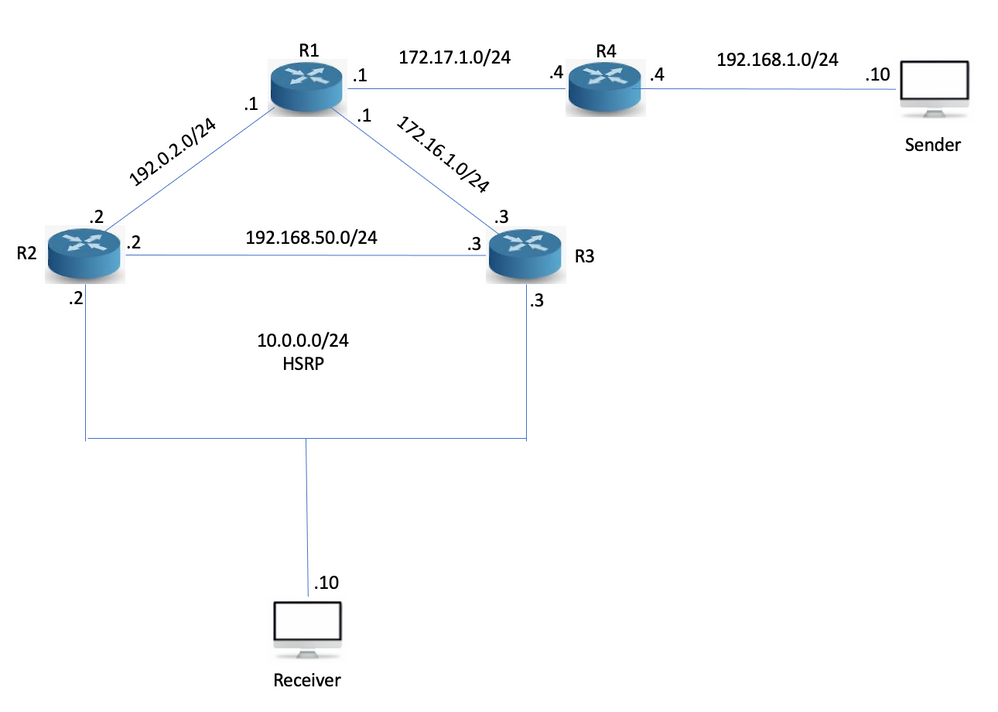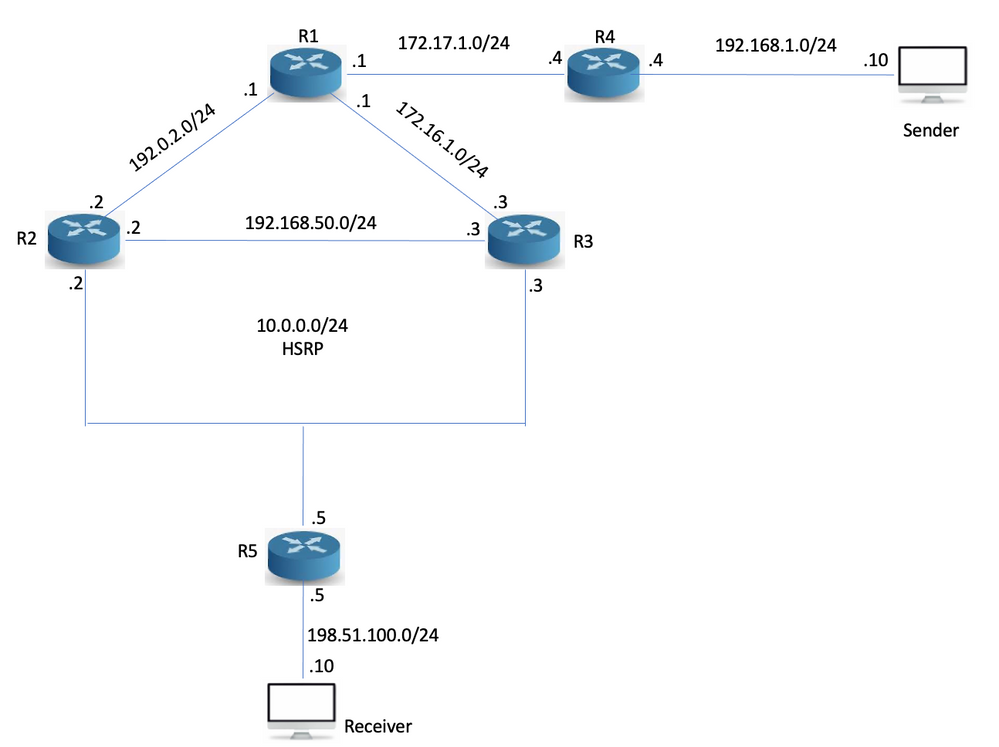HSRP感知PIM故障排除
下載選項
無偏見用語
本產品的文件集力求使用無偏見用語。針對本文件集的目的,無偏見係定義為未根據年齡、身心障礙、性別、種族身分、民族身分、性別傾向、社會經濟地位及交織性表示歧視的用語。由於本產品軟體使用者介面中硬式編碼的語言、根據 RFP 文件使用的語言,或引用第三方產品的語言,因此本文件中可能會出現例外狀況。深入瞭解思科如何使用包容性用語。
關於此翻譯
思科已使用電腦和人工技術翻譯本文件,讓全世界的使用者能夠以自己的語言理解支援內容。請注意,即使是最佳機器翻譯,也不如專業譯者翻譯的內容準確。Cisco Systems, Inc. 對這些翻譯的準確度概不負責,並建議一律查看原始英文文件(提供連結)。
簡介
本檔案介紹如何對熱待命路由器通訊協定(HSRP)感知通訊協定無關多點傳送(PIM)功能及其可使用的情況進行疑難排解。
說明
在需要冗餘的環境中,HSRP會正常運行。HSRP是一個經過驗證的協定,它確實有效,但是當有需要組播的客戶端時,您如何處理?當活動路由器(AR)關閉時,什麼會觸發組播收斂?在這種情況下,使用拓撲1:

拓撲1
此處需要注意的一點是,R3是PIM指定路由器(DR),即使R2是HSRP AR也是如此。網路已設定為開放最短路徑優先(OSPF),PIM和R1是具有10.1.1.1 IP地址的交匯點(RP)。R2和R3都接收網際網路組管理協定(IGMP)報告,但只有R3傳送PIM加入,因為它是PIM DR。R3向RP構建「*,G」:
R3#sh ip mroute 239.0.0.1
IP Multicast Routing Table
Flags: D - Dense, S - Sparse, B - Bidir Group, s - SSM Group, C - Connected,
L - Local, P - Pruned, R - RP-bit set, F - Register flag,
T - SPT-bit set, J - Join SPT, M - MSDP created entry, E - Extranet,
X - Proxy Join Timer Running, A - Candidate for MSDP Advertisement,
U - URD, I - Received Source Specific Host Report,
Z - Multicast Tunnel, z - MDT-data group sender,
Y - Joined MDT-data group, y - Sending to MDT-data group,
G - Received BGP C-Mroute, g - Sent BGP C-Mroute,
N - Received BGP Shared-Tree Prune, n - BGP C-Mroute suppressed,
Q - Received BGP S-A Route, q - Sent BGP S-A Route,
V - RD & Vector, v - Vector, p - PIM Joins on route
Outgoing interface flags: H - Hardware switched, A - Assert winner, p - PIM Join
Timers: Uptime/Expires
Interface state: Interface, Next-Hop or VCD, State/Mode
(*, 239.0.0.1), 02:54:15/00:02:20, RP 10.1.1.1, flags: SJC
Incoming interface: Ethernet0/0, RPF nbr 172.16.1.1
Outgoing interface list:
Ethernet0/2, Forward/Sparse, 00:25:59/00:02:20然後,從組播源ping 239.0.0.1以構建S,G:
Sender#ping 239.0.0.1 re 3
Type escape sequence to abort.
Sending 3, 100-byte ICMP Echos to 239.0.0.1, timeout is 2 seconds:
Reply to request 0 from 10.0.0.10, 35 ms
Reply to request 1 from 10.0.0.10, 1 ms
Reply to request 2 from 10.0.0.10, 2 msS、G已經構建:
R3#sh ip mroute 239.0.0.1
IP Multicast Routing Table
Flags: D - Dense, S - Sparse, B - Bidir Group, s - SSM Group, C - Connected,
L - Local, P - Pruned, R - RP-bit set, F - Register flag,
T - SPT-bit set, J - Join SPT, M - MSDP created entry, E - Extranet,
X - Proxy Join Timer Running, A - Candidate for MSDP Advertisement,
U - URD, I - Received Source Specific Host Report,
Z - Multicast Tunnel, z - MDT-data group sender,
Y - Joined MDT-data group, y - Sending to MDT-data group,
G - Received BGP C-Mroute, g - Sent BGP C-Mroute,
N - Received BGP Shared-Tree Prune, n - BGP C-Mroute suppressed,
Q - Received BGP S-A Route, q - Sent BGP S-A Route,
V - RD & Vector, v - Vector, p - PIM Joins on route
Outgoing interface flags: H - Hardware switched, A - Assert winner, p - PIM Join
Timers: Uptime/Expires
Interface state: Interface, Next-Hop or VCD, State/Mode
(*, 239.0.0.1), 02:57:14/stopped, RP 10.1.1.1, flags: SJC
Incoming interface: Ethernet0/0, RPF nbr 172.16.1.1
Outgoing interface list:
Ethernet0/2, Forward/Sparse, 00:28:58/00:02:50
(192.168.1.10, 239.0.0.1), 00:02:03/00:00:56, flags: JT
Incoming interface: Ethernet0/0, RPF nbr 172.16.1.1
Outgoing interface list:
Ethernet0/2, Forward/Sparse, 00:02:03/00:02:50單播和組播拓撲當前不一致。這可能很重要,也可能不重要。當R3發生故障時會發生什麼情況?
R3(config)#int e0/2
R3(config-if)#sh
R3(config-if)#在R2上的PIM檢測到R3已丟失並接管DR角色之前,不會收到對ping的回覆。使用預設計時器時,這需要60-90秒。
Sender#ping 239.0.0.1 re 100 ti 1
Type escape sequence to abort.
Sending 100, 100-byte ICMP Echos to 239.0.0.1, timeout is 1 seconds:
Reply to request 0 from 10.0.0.10, 18 ms
Reply to request 1 from 10.0.0.10, 2 ms....................................................................
.......
Reply to request 77 from 10.0.0.10, 10 ms
Reply to request 78 from 10.0.0.10, 1 ms
Reply to request 79 from 10.0.0.10, 1 ms
Reply to request 80 from 10.0.0.10, 1 ms您可以提高R2上的DR優先順序,使其成為DR。
R2(config-if)#ip pim dr-priority 50
*May 30 12:42:45.900: %PIM-5-DRCHG: DR change from neighbor 10.0.0.3 to 10.0.0.2 on interface Ethernet0/2HSRP感知PIM是使HSRP AR成為PIM DR的一項功能。它也會從虛擬IP傳送PIM訊息,這在具有通往虛擬IP(VIP)的靜態路由的路由器的情況下非常有用。 思科是這樣描述此功能的:
HSRP感知PIM允許通過HSRP AR轉發組播流量,允許PIM利用HSRP冗餘,避免潛在的重複流量,並啟用故障切換,這取決於裝置中的HSRP狀態。PIM-DR與HSRP AR在同一網關上運行,並維護mroute狀態。
在拓撲1中,HSRP面向客戶端運行,因此,即使此功能聽起來非常適合,它也不能幫助組播收斂。在R2上配置此功能:
R2(config-if)#ip pim redundancy HSRP1 hsrp dr-priority 100
R2(config-if)#
*May 30 12:48:20.024: %PIM-5-DRCHG: DR change from neighbor 10.0.0.3 to 10.0.0.2 on interface Ethernet0/2R2現在是PIM DR,而R3現在在介面E0/2上看到兩個PIM鄰居:
R3#sh ip pim nei e0/2
PIM Neighbor Table
Mode: B - Bidir Capable, DR - Designated Router, N - Default DR Priority,
P - Proxy Capable, S - State Refresh Capable, G - GenID Capable
Neighbor Interface Uptime/Expires Ver DR
Address Prio/Mode
10.0.0.1 Ethernet0/2 00:00:51/00:01:23 v2 0 / S P G
10.0.0.2 Ethernet0/2 00:07:24/00:01:23 v2 100/ DR S P G現在R2具有S、G,您可以看到它是斷言獲勝者,因為R3以前是LAN網段的組播轉發者。
R2#sh ip mroute 239.0.0.1
IP Multicast Routing Table
Flags: D - Dense, S - Sparse, B - Bidir Group, s - SSM Group, C - Connected,
L - Local, P - Pruned, R - RP-bit set, F - Register flag,
T - SPT-bit set, J - Join SPT, M - MSDP created entry, E - Extranet,
X - Proxy Join Timer Running, A - Candidate for MSDP Advertisement,
U - URD, I - Received Source Specific Host Report,
Z - Multicast Tunnel, z - MDT-data group sender,
Y - Joined MDT-data group, y - Sending to MDT-data group,
G - Received BGP C-Mroute, g - Sent BGP C-Mroute,
N - Received BGP Shared-Tree Prune, n - BGP C-Mroute suppressed,
Q - Received BGP S-A Route, q - Sent BGP S-A Route,
V - RD & Vector, v - Vector, p - PIM Joins on route
Outgoing interface flags: H - Hardware switched, A - Assert winner, p - PIM Join
Timers: Uptime/Expires
Interface state: Interface, Next-Hop or VCD, State/Mode
(*, 239.0.0.1), 00:20:31/stopped, RP 10.1.1.1, flags: SJC
Incoming interface: Ethernet0/0, RPF nbr 192.0.2.1
Outgoing interface list:
Ethernet0/2, Forward/Sparse, 00:16:21/00:02:35
(192.168.1.10, 239.0.0.1), 00:00:19/00:02:40, flags: JT
Incoming interface: Ethernet0/0, RPF nbr 192.0.2.1
Outgoing interface list:
Ethernet0/2, Forward/Sparse, 00:00:19/00:02:40, A當R2的LAN介面關閉時,會發生什麼情況?R3能否成為DR?它融合的速度能有多快?
R2(config)#int e0/2
R2(config-if)#shHSRP在R3上變為活動狀態,但PIM DR角色不會收斂,直到PIM查詢間隔已過期(3x hello)。
*May 30 12:51:44.204: HSRP: Et0/2 Grp 1 Redundancy "hsrp-Et0/2-1" state Standby -> Active
R3#sh ip pim nei e0/2
PIM Neighbor Table
Mode: B - Bidir Capable, DR - Designated Router, N - Default DR Priority,
P - Proxy Capable, S - State Refresh Capable, G - GenID Capable
Neighbor Interface Uptime/Expires Ver DR
Address Prio/Mode
10.0.0.1 Ethernet0/2 00:04:05/00:00:36 v2 0 / S P G
10.0.0.2 Ethernet0/2 00:10:39/00:00:36 v2 100/ DR S P G
R3#
*May 30 12:53:02.013: %PIM-5-NBRCHG: neighbor 10.0.0.2 DOWN on interface Ethernet0/2 DR
*May 30 12:53:02.013: %PIM-5-DRCHG: DR change from neighbor 10.0.0.2 to 10.0.0.3 on interface Ethernet0/2
*May 30 12:53:02.013: %PIM-5-NBRCHG: neighbor 10.0.0.1 DOWN on interface Ethernet0/2 non DR發生PIM收斂時,會丟失大量資料包:
Sender#ping 239.0.0.1 re 100 time 1
Type escape sequence to abort.
Sending 100, 100-byte ICMP Echos to 239.0.0.1, timeout is 1 seconds:
Reply to request 0 from 10.0.0.10, 5 ms
Reply to request 0 from 10.0.0.10, 14 ms...................................................................
Reply to request 68 from 10.0.0.10, 10 ms
Reply to request 69 from 10.0.0.10, 2 ms
Reply to request 70 from 10.0.0.10, 1 msHSRP知道PIM在這方面並沒有真正起作用。改為使用拓撲2時,將非常有用:

拓撲2
路由器R5已新增,而接收器位於R5後面。R5不與R2和R3一起運行路由,只與RP和組播源上的靜態路由點一起運行:
R5(config)#ip route 10.1.1.1 255.255.255.255 10.0.0.1
R5(config)#ip route 192.168.1.0 255.255.255.0 10.0.0.1如果沒有HSRP感知PIM,反向路徑轉發(RPF)檢查將失敗,因為PIM對等實體具有實體地址,但R5在網段上看到三個鄰居,其中一個是VIP:
R5#sh ip pim nei
PIM Neighbor Table
Mode: B - Bidir Capable, DR - Designated Router, N - Default DR Priority,
P - Proxy Capable, S - State Refresh Capable, G - GenID Capable
Neighbor Interface Uptime/Expires Ver DR
Address Prio/Mode
10.0.0.2 Ethernet0/0 00:03:00/00:01:41 v2 100/ DR S P G
10.0.0.1 Ethernet0/0 00:03:00/00:01:41 v2 0 / S P G
10.0.0.3 Ethernet0/0 00:03:00/00:01:41 v2 1 / S P GR2是在正常情況下轉發組播的路由器,因為它是通過活動路由器的HSRP狀態的PIM DR:
R2#sh ip mroute 239.0.0.1
IP Multicast Routing Table
Flags: D - Dense, S - Sparse, B - Bidir Group, s - SSM Group, C - Connected,
L - Local, P - Pruned, R - RP-bit set, F - Register flag,
T - SPT-bit set, J - Join SPT, M - MSDP created entry, E - Extranet,
X - Proxy Join Timer Running, A - Candidate for MSDP Advertisement,
U - URD, I - Received Source Specific Host Report,
Z - Multicast Tunnel, z - MDT-data group sender,
Y - Joined MDT-data group, y - Sending to MDT-data group,
G - Received BGP C-Mroute, g - Sent BGP C-Mroute,
N - Received BGP Shared-Tree Prune, n - BGP C-Mroute suppressed,
Q - Received BGP S-A Route, q - Sent BGP S-A Route,
V - RD & Vector, v - Vector, p - PIM Joins on route
Outgoing interface flags: H - Hardware switched, A - Assert winner, p - PIM Join
Timers: Uptime/Expires
Interface state: Interface, Next-Hop or VCD, State/Mode
(*, 239.0.0.1), 00:02:12/00:02:39, RP 10.1.1.1, flags: S
Incoming interface: Ethernet0/0, RPF nbr 192.0.2.1
Outgoing interface list:
Ethernet0/2, Forward/Sparse, 00:02:12/00:02:39嘗試從來源執行ping:
Sender#ping 239.0.0.1 re 3
Type escape sequence to abort.
Sending 3, 100-byte ICMP Echos to 239.0.0.1, timeout is 2 seconds:
Reply to request 0 from 198.51.100.10, 1 ms
Reply to request 1 from 198.51.100.10, 2 ms
Reply to request 2 from 198.51.100.10, 2 msPing工作正常,R2的S、G:
R2#sh ip mroute 239.0.0.1
IP Multicast Routing Table
Flags: D - Dense, S - Sparse, B - Bidir Group, s - SSM Group, C - Connected,
L - Local, P - Pruned, R - RP-bit set, F - Register flag,
T - SPT-bit set, J - Join SPT, M - MSDP created entry, E - Extranet,
X - Proxy Join Timer Running, A - Candidate for MSDP Advertisement,
U - URD, I - Received Source Specific Host Report,
Z - Multicast Tunnel, z - MDT-data group sender,
Y - Joined MDT-data group, y - Sending to MDT-data group,
G - Received BGP C-Mroute, g - Sent BGP C-Mroute,
N - Received BGP Shared-Tree Prune, n - BGP C-Mroute suppressed,
Q - Received BGP S-A Route, q - Sent BGP S-A Route,
V - RD & Vector, v - Vector, p - PIM Joins on route
Outgoing interface flags: H - Hardware switched, A - Assert winner, p - PIM Join
Timers: Uptime/Expires
Interface state: Interface, Next-Hop or VCD, State/Mode
(*, 239.0.0.1), 00:04:18/00:03:29, RP 10.1.1.1, flags: S
Incoming interface: Ethernet0/0, RPF nbr 192.0.2.1
Outgoing interface list:
Ethernet0/2, Forward/Sparse, 00:04:18/00:03:29
(192.168.1.10, 239.0.0.1), 00:01:35/00:01:24, flags: T
Incoming interface: Ethernet0/0, RPF nbr 192.0.2.1
Outgoing interface list:
Ethernet0/2, Forward/Sparse, 00:01:35/00:03:29當R2出現故障時會發生什麼?
R2#conf t
Enter configuration commands, one per line. End with CNTL/Z.
R2(config)#int e0/2
R2(config-if)#sh
R2(config-if)#Sender#ping 239.0.0.1 re 200 ti 1
Type escape sequence to abort.
Sending 200, 100-byte ICMP Echos to 239.0.0.1, timeout is 1 seconds:
Reply to request 0 from 198.51.100.10, 9 ms
Reply to request 1 from 198.51.100.10, 2 ms
Reply to request 1 from 198.51.100.10, 11 ms....................................................................
......................................................................
............................................................
ping超時,因為從R5進入PIM連線時,R3未意識到必須處理該連線。
*May 30 13:20:13.236: PIM(0): Received v2 Join/Prune on Ethernet0/2 from 10.0.0.5, not to us
*May 30 13:20:32.183: PIM(0): Generation ID changed from neighbor 10.0.0.2事實證明,輔助路由器上也必須配置PIM冗餘命令,以便處理PIM與VIP的連線。
R3(config-if)#ip pim redundancy HSRP1 hsrp dr-priority 10配置此連線後,將處理傳入的加入。R3觸發R5傳送新的聯接,因為PIM hello中的GenID設定為新值。
*May 30 13:59:19.333: PIM(0): Matched redundancy group VIP 10.0.0.1 on Ethernet0/2 Active, processing the Join/Prune, to us
*May 30 13:40:34.043: PIM(0): Generation ID changed from neighbor 10.0.0.1進行此配置後,PIM DR角色會以HSRP允許的最快速度收斂。此案例中使用的是雙向轉發檢測(BFD)。
結論
瞭解HSRP感知PIM的關鍵概念如下:
- 最初,AR上的PIM冗餘配置使其成為DR。
- 輔助路由器上也必須配置PIM冗餘,否則,它無法處理PIM與VIP的連線。
- 在PIM hello超時之前,PIM DR角色不會收斂。輔助路由器處理加入,因此組播會收斂。
要點
當您在HSRP LAN上擁有接收器時,此功能不起作用,因為在PIM鄰接關係到期之前,不會移動DR角色。
相關資訊
修訂記錄
| 修訂 | 發佈日期 | 意見 |
|---|---|---|
1.0 |
02-Jun-2022 |
初始版本 |
 意見
意見